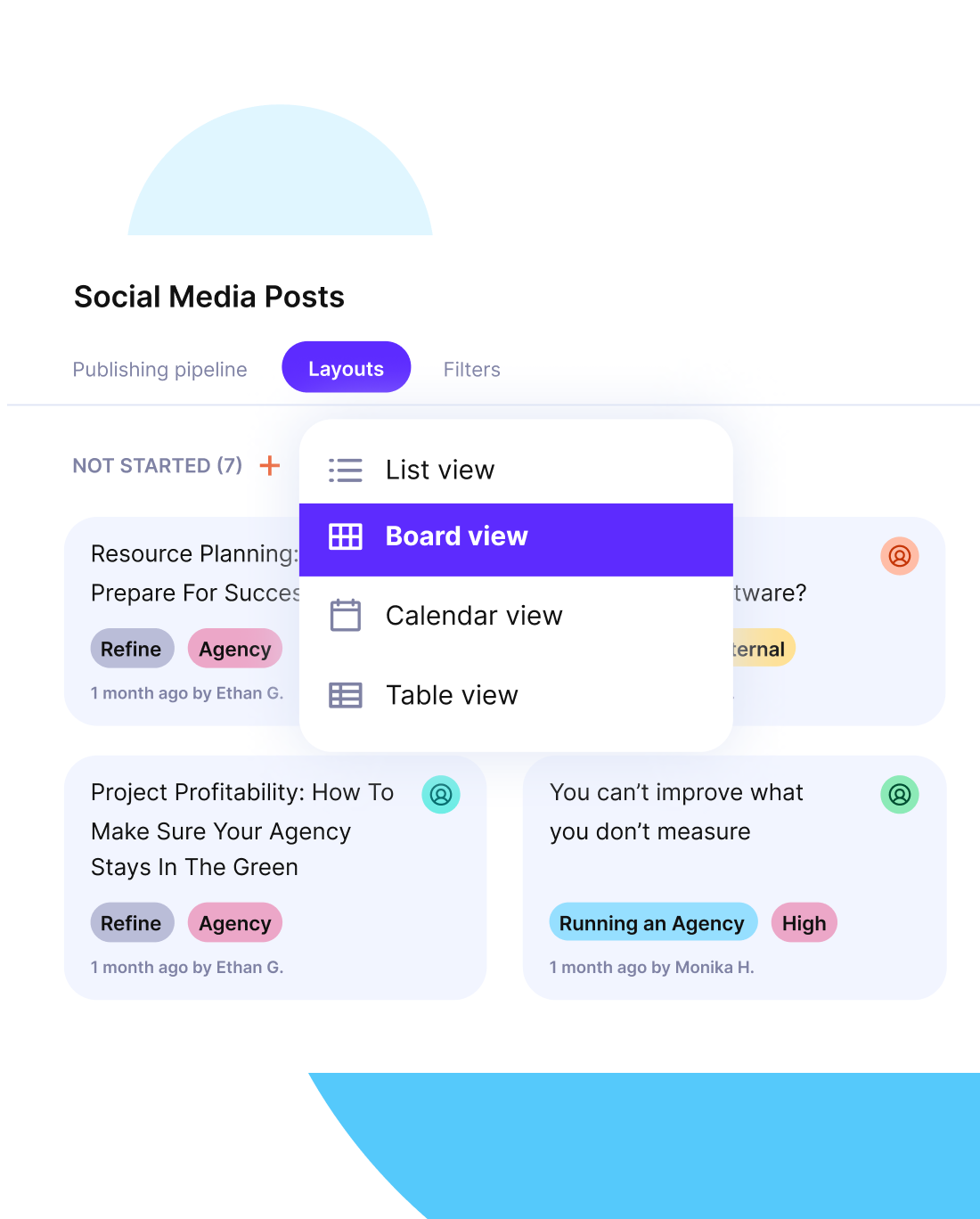What Is Agile Project Management? Beginner’s Guide (2026)
Agile project management is a flexible approach that prioritizes collaboration, customer feedback, and iterative development over rigid, sequential processes.
It’s especially popular in software development, where it consistently leads to higher project success rates.
In this beginner’s guide to Agile, you’ll learn key concepts and best practices, get actionable tips for implementation, and discover top tools for this PM method.
Key Takeaways on Agile
- Agile project management prioritizes flexibility, collaboration, and customer feedback over rigid traditional waterfall approaches that struggle with changing requirements.
- Core values emphasize individuals and interactions, working software, customer collaboration, and responding to change through iterative development cycles.
- Popular methodologies include Scrum with structured sprints, Kanban for continuous flow, and Extreme Programming featuring pair programming and test-driven development.
- This methodology delivers 37% higher project success rates and up to 50% faster delivery through incremental releases and rapid customer feedback integration.
What Is Agile Project Management?
Agile Project Management is an iterative and flexible approach that helps teams respond quickly to changing requirements, originating in software development as an alternative to traditional rigid methodologies.
Unlike traditional approaches, this flexible project management methodology focuses heavily on continuous collaboration, customer feedback, and delivering incremental value rather than extensive upfront planning. In other words, Agile development prioritizes individuals and interactions over rigid procedures.
It welcomes change, fosters collaboration, and drives innovation. If you want to manage Agile teams, you should be comfortable with uncertainty, frequently adjust your plans based on user feedback, and prioritize working outcomes over exhaustive documentation.
In the sections below, we’ll get back at the differences between traditional (waterfall) project management techniques.
Differences Between Traditional and Agile Methodology
The key difference between traditional and Agile methodologies is that traditional approaches follow a rigid, linear process, while Agile methods rely on iterative cycles and continuous feedback.
Agile prioritizes flexibility and customer involvement throughout the project, allowing for ongoing adjustments based on real-time needs. Traditional methods typically limit changes once a project is underway, but both fit within broader methodology frameworks that guide how projects are structured and delivered.
As research from MoldStud states:
Research shows that organizations employing iterative frameworks see a 37% higher project success rate compared to traditional methods.
Other interesting stats from the study highlight three factors contributing to the higher success rate:
- Daily stand-up meetings enhance team communication and collaboration, reducing project risks by 22%.
- Regular user feedback during development boosts user satisfaction rates by 71%.
- Rapid iteration and prototyping accelerate release times by up to 30% compared to linear methods.
In case you’re wondering how Agile compares to other project management methods, you’ll find your answers in the table below:
| Methodology | Best For | Major Differences | Avoid If |
|---|---|---|---|
| Agile Management | Fast-paced projects requiring frequent adjustments and stakeholder feedback. | Iterative, flexible, and adaptive; encourages continuous improvement and user involvement. | Project scope is clearly defined and unlikely to change significantly. |
| Waterfall | Projects with fixed requirements and well-defined sequential stages. | Linear, structured phases; changes require formal approval and may cause delays. | Your project demands frequent revisions or ongoing user feedback. |
| Hybrid | Projects needing both structure and flexibility to adapt to changing conditions. | Combines sequential phases with iterative cycles; balances clarity and adaptability. | You require strict adherence to either fully Agile or fully traditional approaches. |
| Scrum (Agile subset) | Complex projects demanding regular check-ins and structured iterations. | Time-boxed “sprints,” clearly defined roles, and regular retrospective meetings. | Your team struggles with rapid cycles or structured role requirements. |
| Kanban (Agile subset) | Ongoing projects or maintenance tasks with continuous workflows. | Visualizes tasks using boards; limits work-in-progress for smooth task handling. | Your project has rigid, time-sensitive phases with strict deadlines. |
What Are the Core Values of Agile PM?
The four core values of Agile are: individuals and interactions over processes and tools, working software over comprehensive documentation, customer collaboration over contract negotiation, and responding to change over following a strict plan.
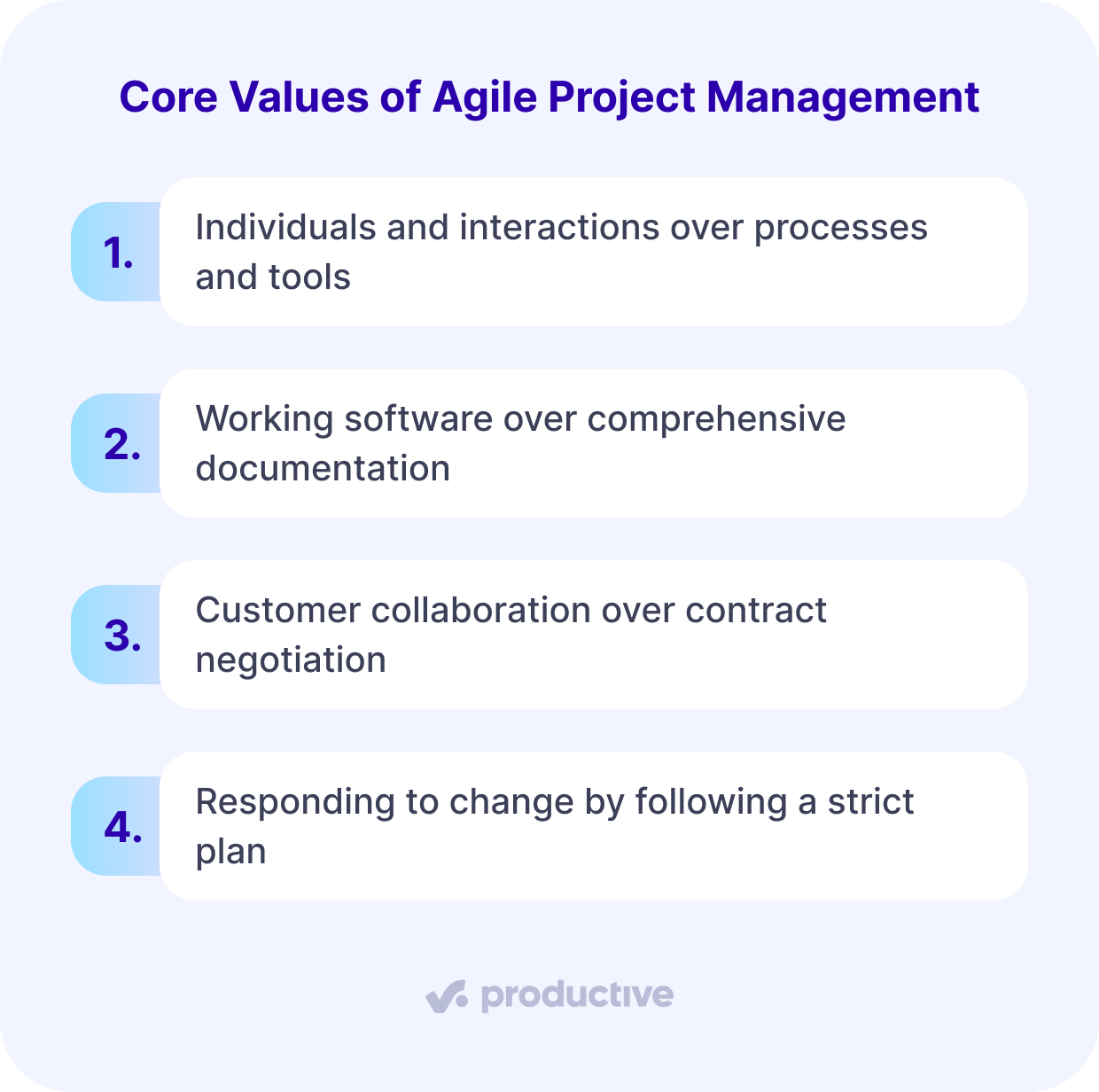
Here’s how these values impact the project delivery process:
- Individuals and interactions over processes and tools: The people-first approach fosters better teamwork and clearer communication. It also enables quicker problem-solving and more innovative solutions compared to rigid reliance on procedures and software alone.
- Working software over comprehensive documentation: Delivering functioning products (or MVPs) early and providing immediate value to customers. It also reduces misunderstandings and helps teams receive critical feedback for timely improvements.
- Customer collaboration over contract negotiation: When you collaborate closely with customers early on, you ensure that products align closely with actual user needs. You can also make adjustments based on continuous input rather than being constrained by inflexible contracts.
- Responding to change by following a strict plan: Your team needs to be adaptable to quickly respond to evolving requirements and unexpected product developments. This is how you ensure the final product stays relevant and valuable even as circumstances change.
12 Guiding Principles of Agile Work
According to the Agile Manifesto, there are twelve Agile principles. These translate abstract concepts into actionable practices of Agile working for project teams. Stick with these concepts to ensure your project remains flexible, responsive, and focused on delivering real customer value.
- Regular delivery: Provide usable results frequently through short cycles or iterations, allowing ongoing improvements based on customer feedback.
- Embracing change: Quickly adapt plans to reflect new customer requirements and shifting priorities, keeping your project aligned with evolving needs.
- Frequent collaboration with customers: Actively involve customers throughout development to ensure the final product closely matches their expectations.
- Empowering motivated teams: Build self-organizing teams where motivated individuals take ownership and responsibility for their work.
- Face-to-face communication: Prioritize direct conversations among team members for clarity, quicker problem-solving, and stronger relationships.
- Working software as a primary success measure: Focus on tangible results over extensive documentation or intermediate deliverables to confirm continuous progress.
- Sustainable development pace: Maintain a steady, sustainable pace that prevents burnout, keeping productivity and quality high throughout the project lifecycle.
- Technical excellence: Continuously emphasize high standards in design, development, and testing to ensure quality and responsiveness to changes.
- Simplicity: Keep procedures and solutions as straightforward as possible, reducing complexity and minimizing wasted effort.
- Self-organizing teams: Allow teams autonomy in decision-making, enabling them to find effective solutions without rigid oversight.
- Regular reflection and improvement: Periodically evaluate team performance and make necessary adjustments to continuously enhance effectiveness.
- Alignment between business and development: Ensure continuous collaboration between business stakeholders and development teams, maintaining clear alignment toward common goals.
According to the Agile Manifesto, there are twelve Agile principles. These translate abstract concepts into actionable practices of Agile working for project teams. Stick with these concepts to ensure your project remains flexible, responsive, and focused on delivering real customer value. Applying Agile principles in hybrid teams helps bridge the gap between remote and in-office collaboration, ensuring flexibility, transparency, and continuous delivery remain at the core of project success.
Agile Project Management Frameworks Overview
The most commonly used Agile project management frameworks are Scrum, Kanban, Extreme Programming (XP), feature-driven development, and Lean.
Here’s what sets them apart:
- Scrum breaks project delivery into fixed-length sprints and assigns clear roles like Product Owner and Scrum Master.
- Kanban uses visual boards to pull tasks through a continuous flow.
- Extreme Programming (XP) doubles down on engineering best practices, like pair programming and test-driven development (it prefers clean code).
- Feature-Driven Development structures work around small, client-valued features.
- Lean Project Management cuts waste and maximizes value.
In total, there are around ten frameworks and new approaches. We’ll cover them in another article. In case you’re here for a quick overview, there’s another framework comparison below.
If you’re here just for the top five, scroll down a bit to get the details (what’s the framework about) and links for more comprehensive guides.
| Agile Frameworks | Description | When to Use | When Not to Use |
|---|---|---|---|
| Scrum (Scrum Framework) | You break project delivery into 1–4 week sprints, assign roles (Product Owner, Scrum Master), hold stand-ups, and review each sprint’s deliverables. | Projects with evolving requirements that benefit from frequent checkpoints. | Teams unable to commit to stable sprint lengths or roles. |
| Kanban (Kanban Method) | You visualize workflow on a board, limit work-in-progress, and pull tasks as capacity frees up, focusing on continuous delivery. | Ongoing support or maintenance operations where priorities shift constantly. | Projects needing fixed delivery dates or planned phases. |
| Extreme Programming (XP) | You pair-program, write tests first (TDD), integrate continuously, and refactor code to maintain high technical quality. | Software projects demanding rigorous quality and rapid feedback loops. | Non-software or low-complexity projects. |
| Lean Software Development | You map value streams, eliminate waste, deliver only what brings value, and continuously improve procedures. | Teams focused on efficiency and reducing overhead. | Projects requiring heavy upfront planning and documentation. |
| Crystal (Crystal Methods) | You tailor your practices (Clear, Orange, Red variants) to team size and project criticality, emphasizing communication. | Small to medium groups where communication is key and overhead must stay low. | Projects needing strict controls. |
| Feature-Driven Development (FDD) | You build a detailed feature list, model the domain, plan two-week feature-driven iterations, and produce regular builds. | Projects with clear feature requirements and a need for structured planning. | Initiatives without well-defined feature sets. |
| DSDM (Dynamic Systems Development Method) | You follow defined phases (Feasibility, Foundations, Exploration, Engineering, Deployment) and use MoSCoW prioritization to manage scope. | Enterprise projects needing strong governance and stakeholder involvement. | Small groups or low-stakeholder environments. |
| Agile Unified Process (AUP) | You adopt a lightweight, iterative version of the Rational Unified Process, cycling through Inception, Elaboration, Construction, and Transition. | Colleagues are familiar with RUP who want to introduce agility. | Teams fully committed to other frameworks. |
| SAFe (Scaled Agile Framework) | You align multiple teams via Agile Release Trains and Program Increments, using Lean principles at enterprise scale. | Large organizations needing to synchronize dozens of teams. | Small teams or single-team projects. |
| LeSS (Large-Scale Scrum) | You apply Scrum across multiple teams using one product backlog, joint sprint planning, and combined reviews. | Scaling Scrum for 2–8 teams working on the same product. | Projects with fewer than two Scrum teams. |
Scrum
Scrum helps teams tackle complex product development projects by breaking project delivery into short, 2–4 week sprints where you ship small improvements each cycle.
Here, you’ll have three key roles:
- Product Owner (sets product backlog priorities)
- Scrum Master (removes blockers)
- Development Team (builds the product)
Every sprint includes four rituals: planning (also known as sprint planning) the work, quick stand-ups, a review of what you built (user stories), and a sprint retrospective to improve your process.
A visual Scrum board keeps everyone’s progress and priorities in plain sight. If this framework catches your eye, you’ll love our detailed guide on Scrum principles and best practices.
Manage Agile projects with Productive
Kanban
Kanban keeps project progress moving, it visualizes every task on a board with moving columns. Each column marks a stage from “To Do” through “Done” (from left to right). You set limits on how many items can sit in each column at once, so you’re forced to finish existing tasks before taking on more.
Here, there are no fixed-length sprints; tasks flow continuously, and you make small tweaks as you learn from real-time data. This approach gives you clear, live insight into what’s blocking progress, helps you deliver updates whenever they’re ready, and drives ongoing efficiency gains.
We talk more about it in our Kanban guide with examples and best practices.
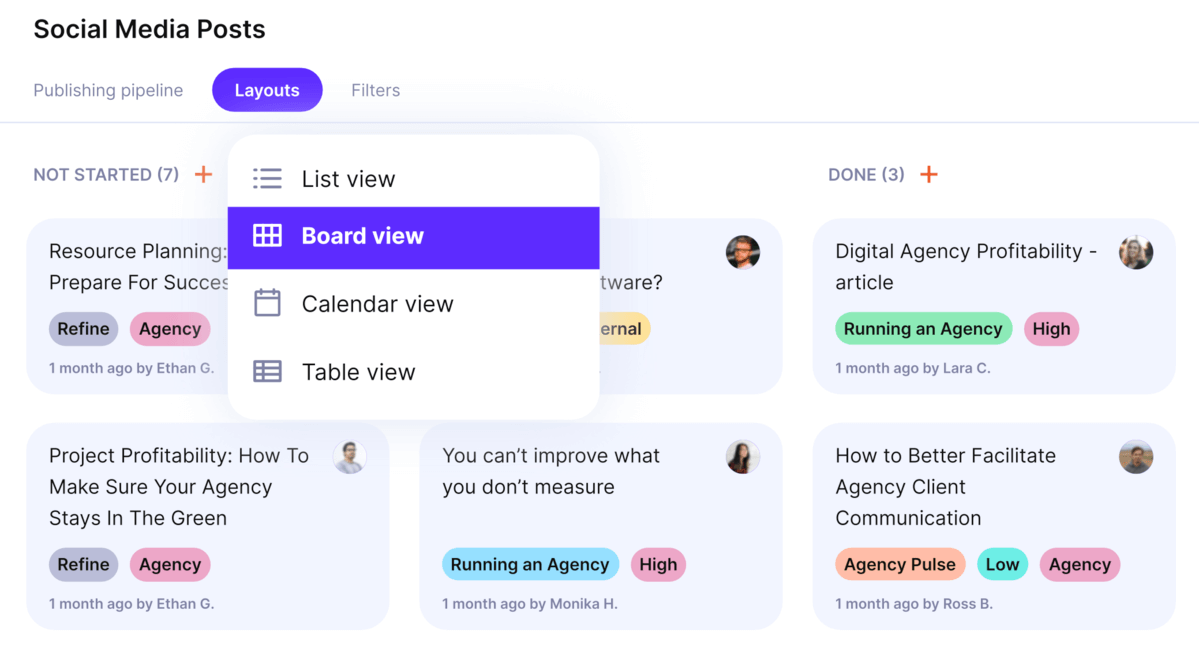
Manage sprints in Productive’s Kanban view.
Extreme Programming
Extreme Programming has very short 1–3 week cycles, and heavy collaboration to keep customer needs front and center. Here, you’ll work in pair-programming duos at one workstation and write your tests before you write your code (test-driven development).
This approach uses frequent check-ins with customers to guide each iteration, so you only build the features you really need. Extreme Programming aims to keep things simple and constantly refine your work.
It helps your team adapt quickly, improve quality, and take full ownership of the product.
Feature-Driven Development
Feature-driven development uses the classic Agile approach – your team focuses on delivering small, client-valued features instead of tackling nebulous technical tasks.
Usually, you’ll go over five clear steps: build an overall model, list all the features, plan by feature, design by feature, and then build by feature.
Here, it’s super important that everyone knows exactly what to deliver and when. FDD works best on larger teams handling complex projects: chief programmers lead the process, feature teams own each feature piece, and you lay down a solid upfront model so your deliverables always match client expectations.
Lean Project Management
Lean project management shifts the development focus from feature organization to waste elimination to create streamlined software delivery processes.
This approach maximizes value by identifying and removing non-value-added activities through techniques like value stream mapping. It emphasizes incremental delivery and customer collaboration rather than traditional Waterfall methods.
You begin by mapping your entire workflow (e.g., identify delays like extra approvals or handoffs that slow you down). Then you switch to small, bite-sized action item batches, only starting new tasks when you’ve cleared existing ones (a pull system).
After each batch, you gather feedback immediately and adjust your process in brief retrospectives. The goal of this constant waste removal and tightened feedback loop is to cut delivery time, reduce defects, and keep your teams focused on the tasks that really matter.
What Are the Benefits of Agile Project Management (APM)?
The benefits of applying Agile in digital project management are boosts in adaptability, collaboration, and delivery speed by breaking work into short, feedback-driven cycles.
You’ll also gain higher customer satisfaction (thanks to continuous feedback loops), better resource use (through focused sprints), and faster time to market (since your teams respond quickly to change).
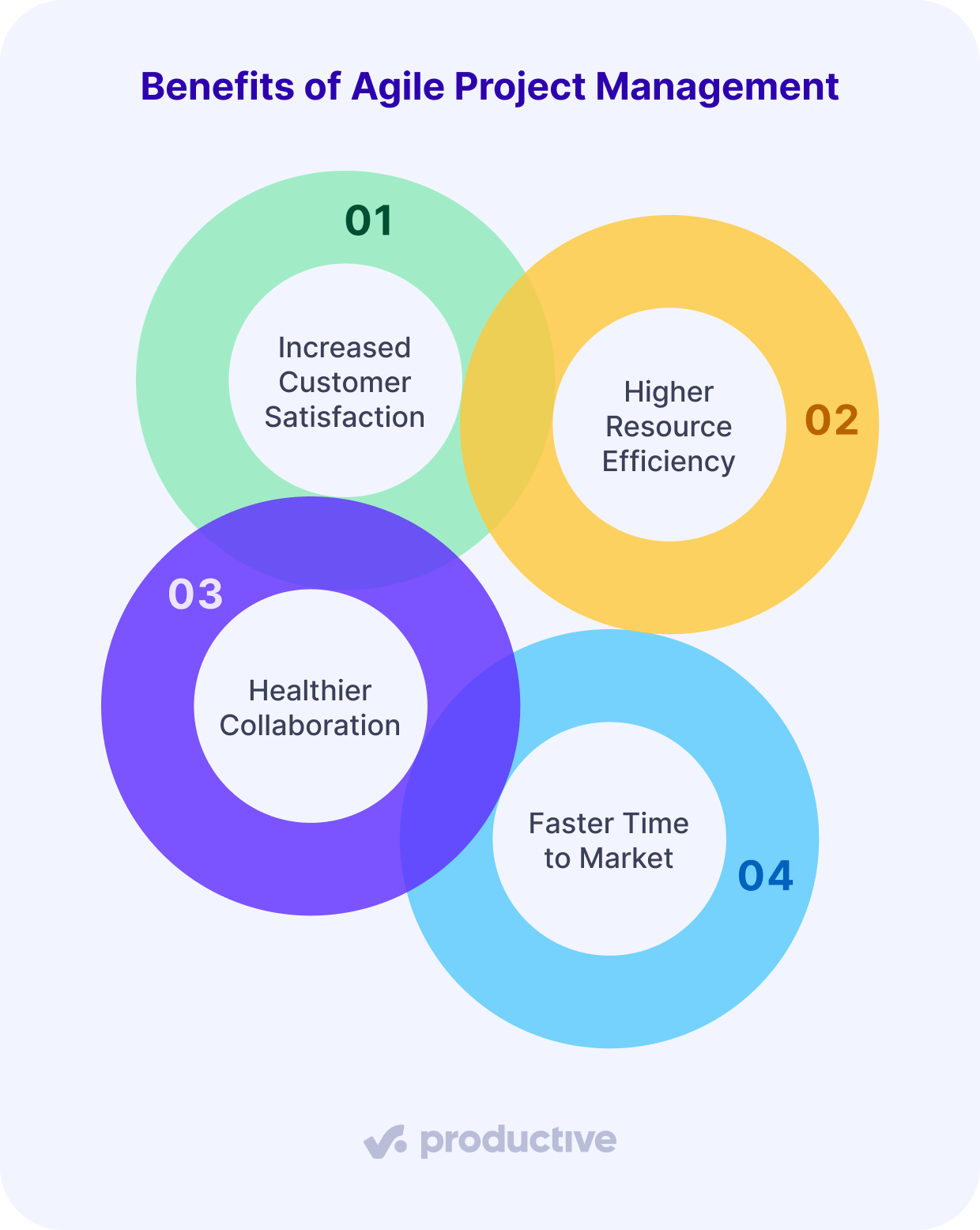
Increased Customer Satisfaction
Iterative cycles enable faster delivery of working features while maintaining continuous dialogue with stakeholders. This approach guarantees your products align with customer expectations through regular communication and updates.
- Rapid Response Capabilities: You can quickly adapt to changing customer needs and preferences through flexible development cycles.
- Enhanced Stakeholder Involvement: Your clients experience greater ownership through continuous feedback integration and collaborative decision-making.
- Measurable Satisfaction Improvements: Organizations typically report 20-30% increases in customer engagement rates.
Teams Can Better Adapt To Change
The management approaches we’ve discussed so far have a huge potential to transform uncertainty from a liability into an asset through iterative cycles that make space for shifting requirements.
Your project management approach becomes more flexible, enabling rapid pivots when market conditions evolve, or customer priorities shift.
This adaptability comes from the method’s structure, which breaks projects into manageable sprints, allowing you to assess progress continuously and adjust direction without derailing entire initiatives or compromising quality standards.
Higher Resource Efficiency – Especially in Software Development
While traditional project management often locks resources into rigid schedules and predetermined allocations of resources, Agile methodologies create fluid systems that maximize every hour, dollar, and team member’s contribution.
With Scrum or Kanban, you break tasks into small chunks, track progress in real-time, and tackle bottlenecks as soon as they appear.
Here’s how you’ll boost efficiency with this method:
- Prioritize high-value features in each sprint.
- Use live dashboards to spot and fix slowdowns immediately (we’ll get back to Agile project management software later).
- Deliver in short cycles to keep work and your people moving nonstop.
Healthier Collaboration
The method is super beneficial for developing healthy teamwork because it makes open communication and shared ownership the norm. Its everyday stand-ups and reviews of sprints keep your team in constant sync and quickly adapting to new information together.
Visual boards (Scrum or Kanban) give everyone a clear insight into who’s doing what and where help is needed. Since customers are involved in the conversation at step one, you build trust and ensure you’re solving real problems.
Faster Time to Market
You can also deliver functional product increments through iterative cycles, allowing rapid customer feedback integration. You’ll achieve up to 50% faster delivery times compared to traditional approaches because you focus on execution rather than extensive documentation.
This methodology helps you identify market needs more effectively through continuous releases and customer input.
- Iterative development cycles allow you to deliver small, functional increments quickly.
- Reduced planning overhead lets you concentrate more on value delivery and execution.
- Continuous customer feedback enables faster adaptation to market demands and requirements.
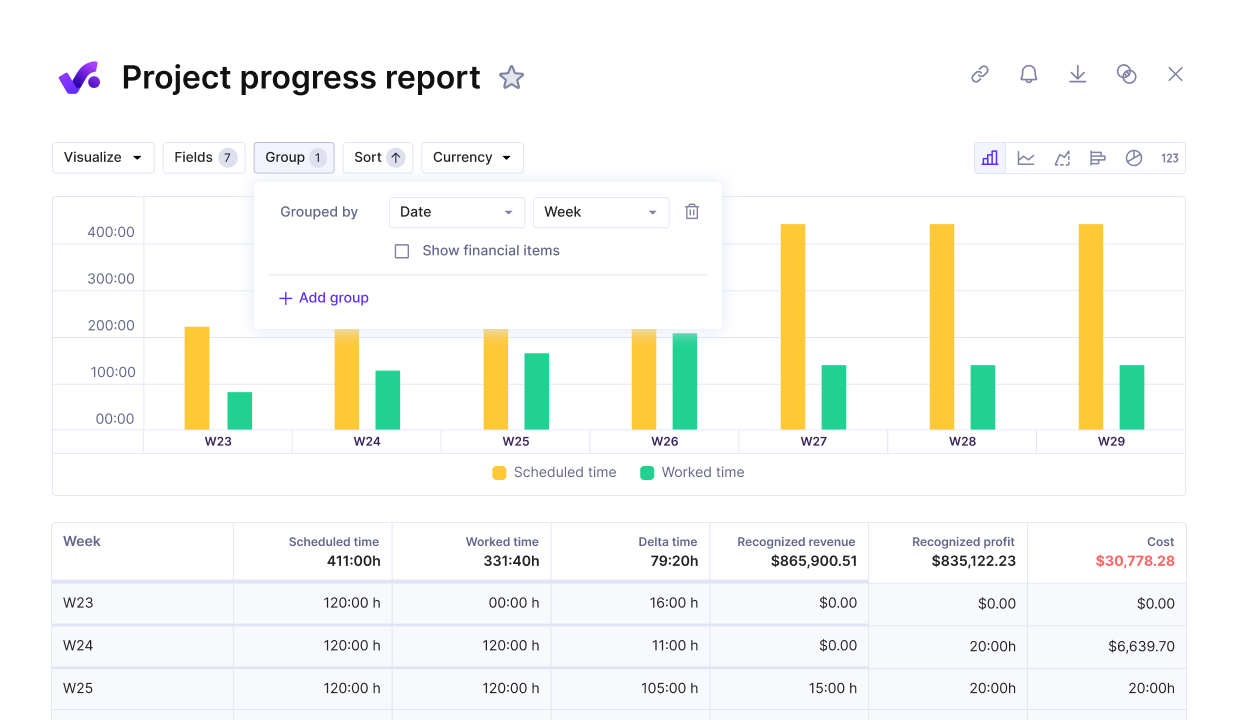
Track project progress, remaining budgets and the time spent on tasks in one view.
When To Use Agile Project Management?
Use Agile when your project requirements are likely to change; you have the flexibility to adjust deadlines, and stakeholders can give continual feedback.
It works best if your team is comfortable collaborating closely if they’re fine with adapting on the go and breaking work into short, iterative cycles instead of a fixed plan.
Before you switch, make sure you have clear stakeholder engagement, loose timeline constraints, and a team eager to embrace frequent check-ins and rapid course corrections.
To help you with the question of when to use Agile PM, we’ve made a neat checklist table below.
| Question | If Yes… | If No… |
|---|---|---|
| Do requirements change often? | Agile’s is very good at adapting to change. | Consider Waterfall or a hybrid approach. |
| Can you deliver work in small, usable chunks? | You can run sprints delivering value every cycle. | You might have to use longer, phase-based cycles instead. |
| Will stakeholders provide regular feedback? | You’ll keep the backlog healthy and aligned. | Schedule stakeholder check-ins or use a different model. |
| Do you need to get to market quickly? | Agile’s short iterations speed your releases. | A more predictable, slower cadence might suffice. |
| Does your team understand Agile basics? | You can hit the ground running with minimal training. | Plan an “basics” workshop before kicking off. |
| Is your team eager to collaborate daily? | Stand-ups and retrospectives will flow naturally. | Work on team alignment and trust first. |
| Does leadership support a flexible approach? | You’ll get the support needed to remove blockers. | Secure leadership buy-in or choose a more top-down model. |
| Does your project management software support sprints and visual boards? | You can visualize work and track progress easily. | Set up or adopt an Agile-friendly tool before starting. |
How to decide Agile is the best fir for your project?
It’s actually super simple. If your answers are:
- Mostly Yes: Nothing more to think about. Launch a pilot sprint, train your team, and iterate based on real feedback.
- Mostly No: Hold off on full Agile. Address the “No” items like stakeholder availability, training, or toolkit. It’s probably a good idea to explore a hybrid or traditional framework first.
What Are the Responsibilities of Agile Project Managers?
An Agile project manager’s responsibilities are to keep their team delivering value every sprint. You do this by removing blockers (like fixing stalled build servers or clarifying or ambiguous requirements).
You also run all Agile rituals on time and with purpose: sprint planning to set goals, performing stand-ups every day to flag issues, reviews of sprints to demo progress, and retrospectives to agree on improvements.
You partner with the Product Owner to keep the backlog sharp and prioritized, track sprint health with burndown charts or Kanban boards, and share clear status updates with stakeholders.
Finally, you coach the team on better estimating, tighter definitions of “done,” and smoother workflows so every sprint gets more predictable and productive.
How To Implement Agile + Best Practices
You can implement Agile by forming a small cross-functional team, selecting Scrum or Kanban, running regular ceremonies (planning, stand-ups, reviews, retrospectives), using tools like Jira or Trello to track work, and iteratively measuring velocity and refining processes sprint by sprint.
Below, we’ll break down the implementation process into practical steps; we’ll also pack the best practices in each step.
STEP 1: Debunk Common Myths
Agile methodology still requires regular planning; your team will refine the backlog and plan each sprint. It’s the manager’s job to write the documentation and set up KPS and other project-tracking metrics. Remember that this technique isn’t just for developers; any project with changing requirements and frequent reviews can use it.
Best tip: Hold a short kickoff meeting to set clear expectations and manage common misconceptions before your first sprint.
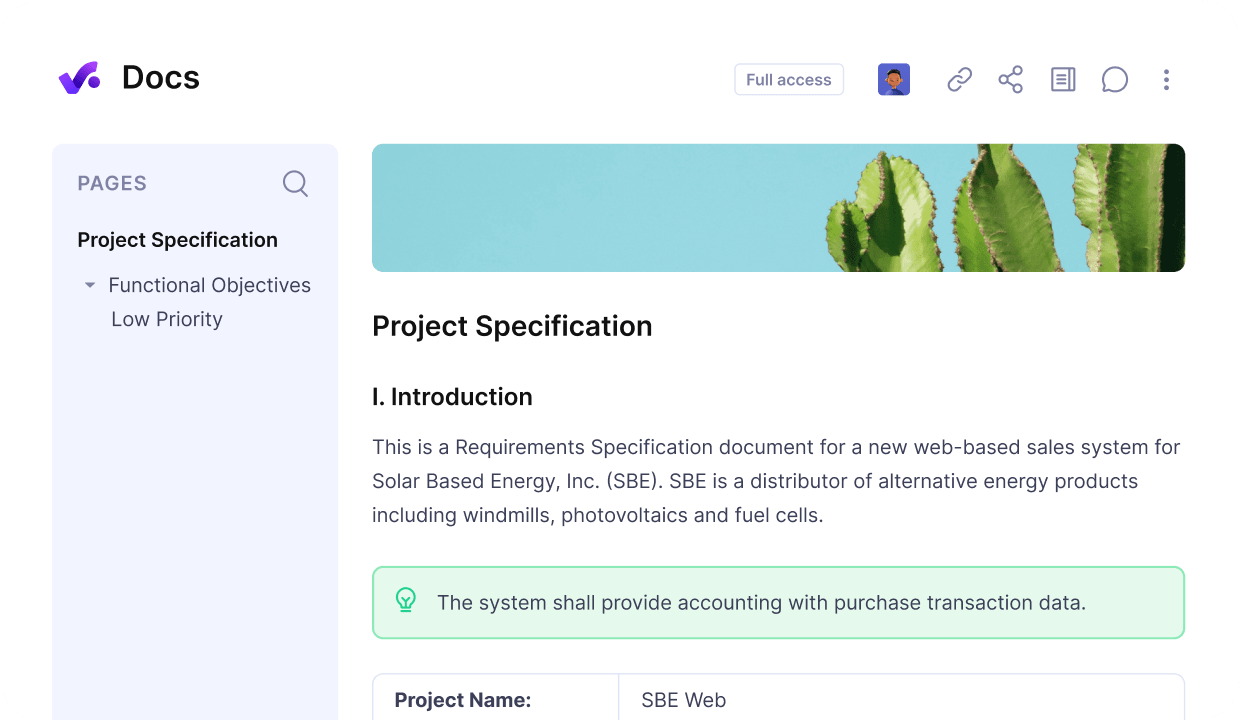
Collaborate, edit and share project documentation in Productive.
STEP 2: Build Your Agile Team
Put together a small, cross-functional squad with a clear Product Owner to prioritize work and a Scrum Master to clear obstacles. Encourage each person to own their tasks and speak up during the stand-ups.
Best tip: Limit your team to 5–9 people so communication stays easy and decisions happen fast.
STEP 3: Choose & Roll Out a Framework
Pick Scrum if you need fixed-length sprints and regular demos or Kanban if you want continuous flow without time-boxed iterations. Map your process on a visible board, set WIP limits for Kanban, or define crisp sprint goals for Scrum.
Best tip: Run a two-week pilot with your chosen framework and board setup—then tweak it based on real-world feedback.
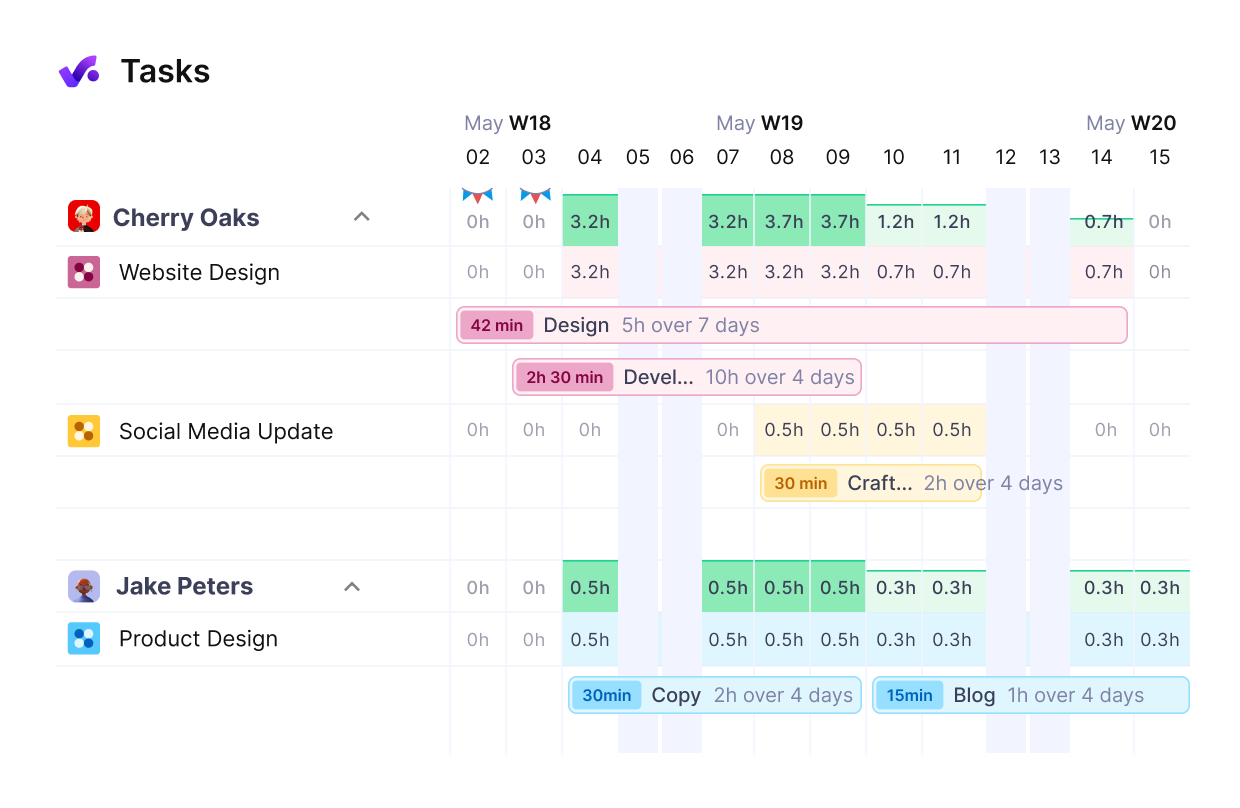
Easily set up tasks and sprints in Productive.
STEP 4: Establish Core Ceremonies
- Sprint Planning: Break top backlog items into sprint-sized tasks.
- Daily Stand-ups: Hold 5-minute check-ins to share progress, blockers, and next steps.
- Sprint Review: Demo working increments to stakeholders at the end of each cycle.
- Retrospective: Identify one or two concrete improvements for the next sprint.
Best tip: Track the time of each ceremony – meetings shouldn’t go over the allocated time.
STEP 5: Implement the Right Agile Tools
Use Agile project management software like Jira or Productive to track your backlog, sprints, and impediments. Integrate with Slack or Teams for chat and GitHub or GitLab for code. If you’re having a hard time deciding which Agile tools to use, you should have a look at our top Agile project management software list.
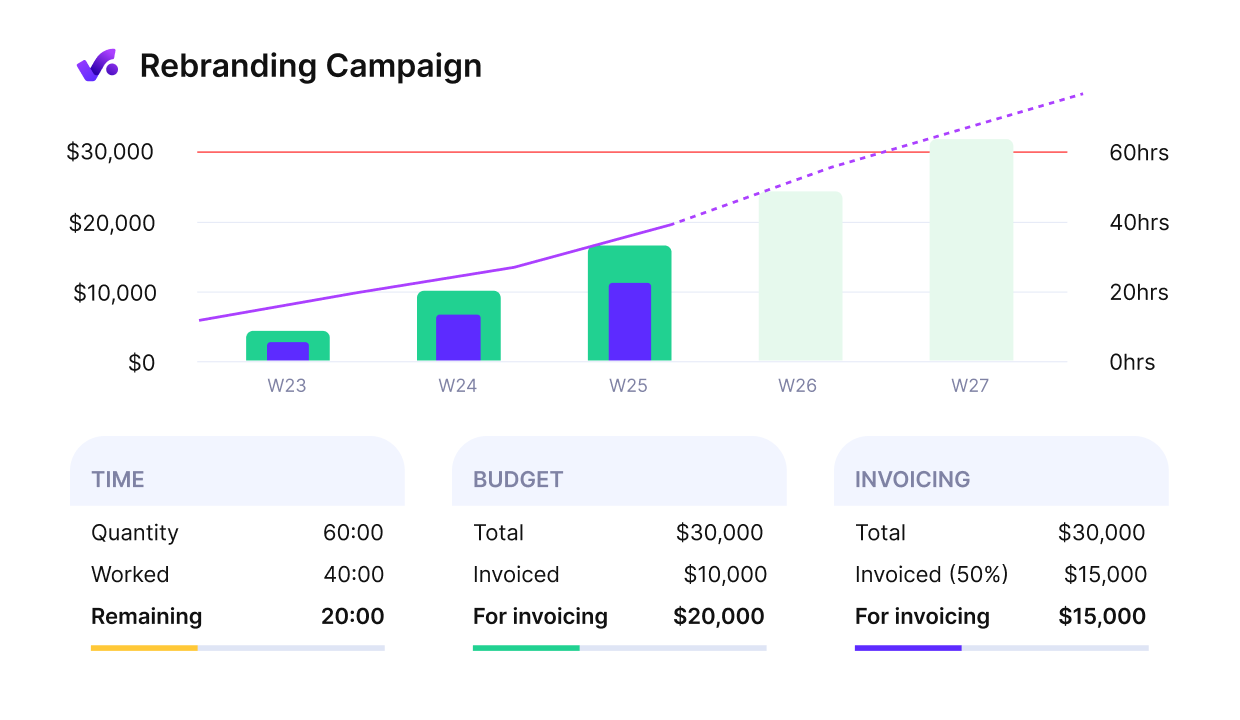
Track costs and spent time on delivering projects.
Best tip: Automate your burndown charts and notifications so you spend less time on reporting and more on delivery.
STEP 6: Measure & Adapt
Track sprint velocity and burndown to assess capacity and forecast future work. After each retrospective, choose one change (like refining your “done” criteria or shortening stand-ups) and estimate (and verify) its impact in the next sprint.
Best tip: Display your metrics on a shared dashboard so the whole Agile team can see progress and drive improvements.
STEP 7: Encourage and Cultivate an Agile Mindset
Encourage honest feedback in sprint reviews and retrospectives. Celebrate each small win to build momentum, and treat every setback as a learning opportunity.
Best tip: Start each retrospective by calling out one success and one lesson – this keeps the Agile teams focused on continuous improvement.
Closing Thoughts on Managing Agile Projects
Now, you know all about Agile’s core concepts, methods, and best practices. Remember that successful agile adoption requires commitment from your entire team, proper training, and willingness to embrace iterative improvement. Start small, learn from each sprint, and gradually scale your agile practices as your company grows.
You can’t use Agile if you don’t have the right tools set in place. Other than looking for a specialized solution and patching it with another specialized solution for another process (e.g., tracking time on sprints or invoicing your clients for the tracked time), you should keep all business operations under one roof.
In case you could use an all-in-one solution to Agile project management, book a demo with Productive.
Manage Agile Workflows with Productive
Manage tasks, track delivery, refine with actionable project data and collaborate in one workspace. Get started with Productive for free.
